Leadership & Management: Motivational Theories in Organizations
VerifiedAdded on 2023/06/15
|8
|921
|352
Essay
AI Summary
This essay delves into the critical role of motivation in organizations, examining several key motivational theories and their practical implications. It begins with Maslow's hierarchy of needs, emphasizing the importance of fulfilling self-actualization and esteem needs to drive employee performance. The essay then explores McClelland's motivational theory, highlighting the significance of rewarding employees and providing leadership opportunities. Herzberg's motivational factors are also analyzed, focusing on the distinction between satisfiers and hygiene factors. Furthermore, the essay discusses goal-setting theory and the importance of setting SMART goals to motivate employees. The self-efficacy theory is examined, emphasizing the role of individual belief in one's abilities. Finally, the essay highlights the significance of intrinsic rewards in fostering a sense of purpose and recognizing employee achievements. The theories outlined provide a comprehensive understanding of how leaders can effectively motivate employees to achieve organizational objectives.
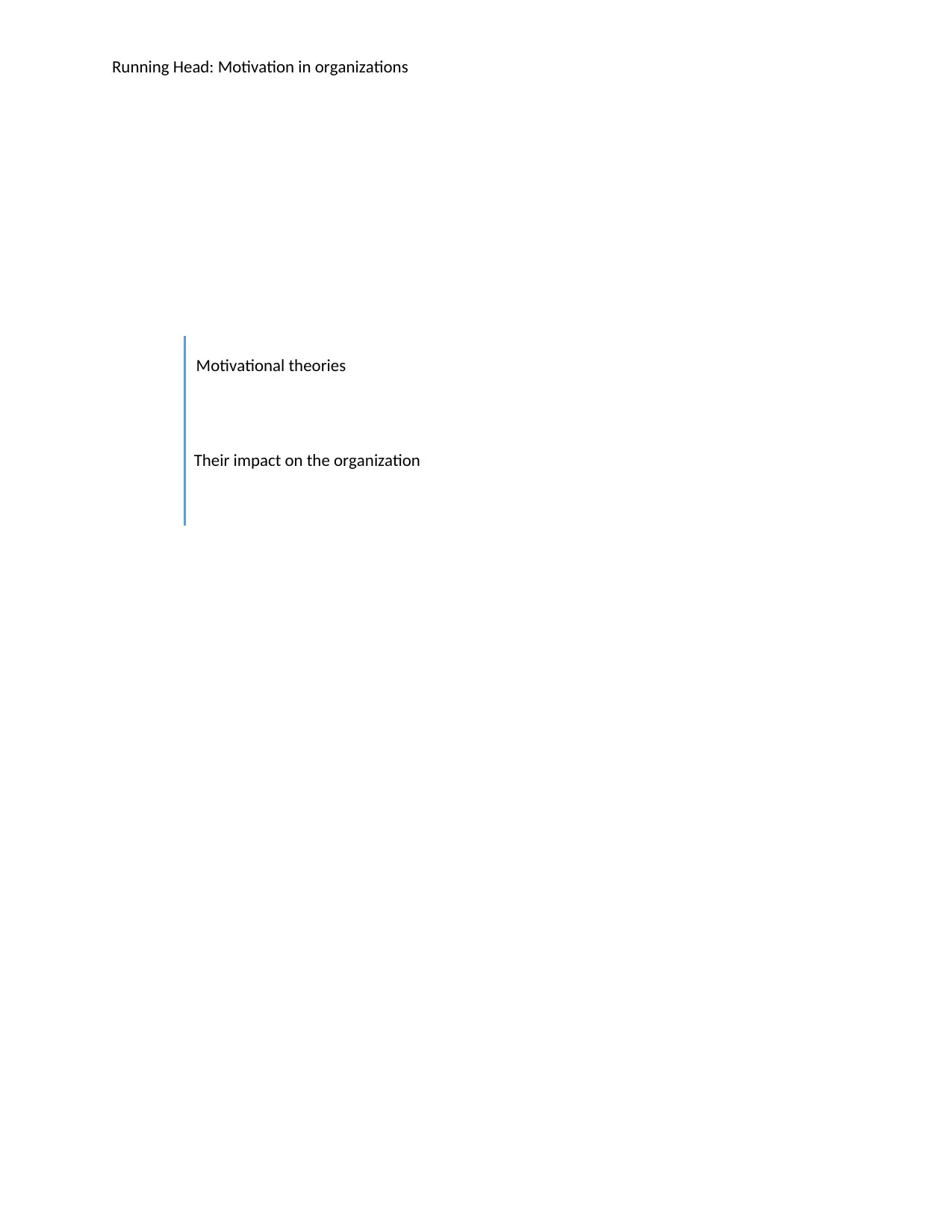
Running Head: Motivation in organizations
Motivational theories
Their impact on the organization
Motivational theories
Their impact on the organization
Paraphrase This Document
Need a fresh take? Get an instant paraphrase of this document with our AI Paraphraser
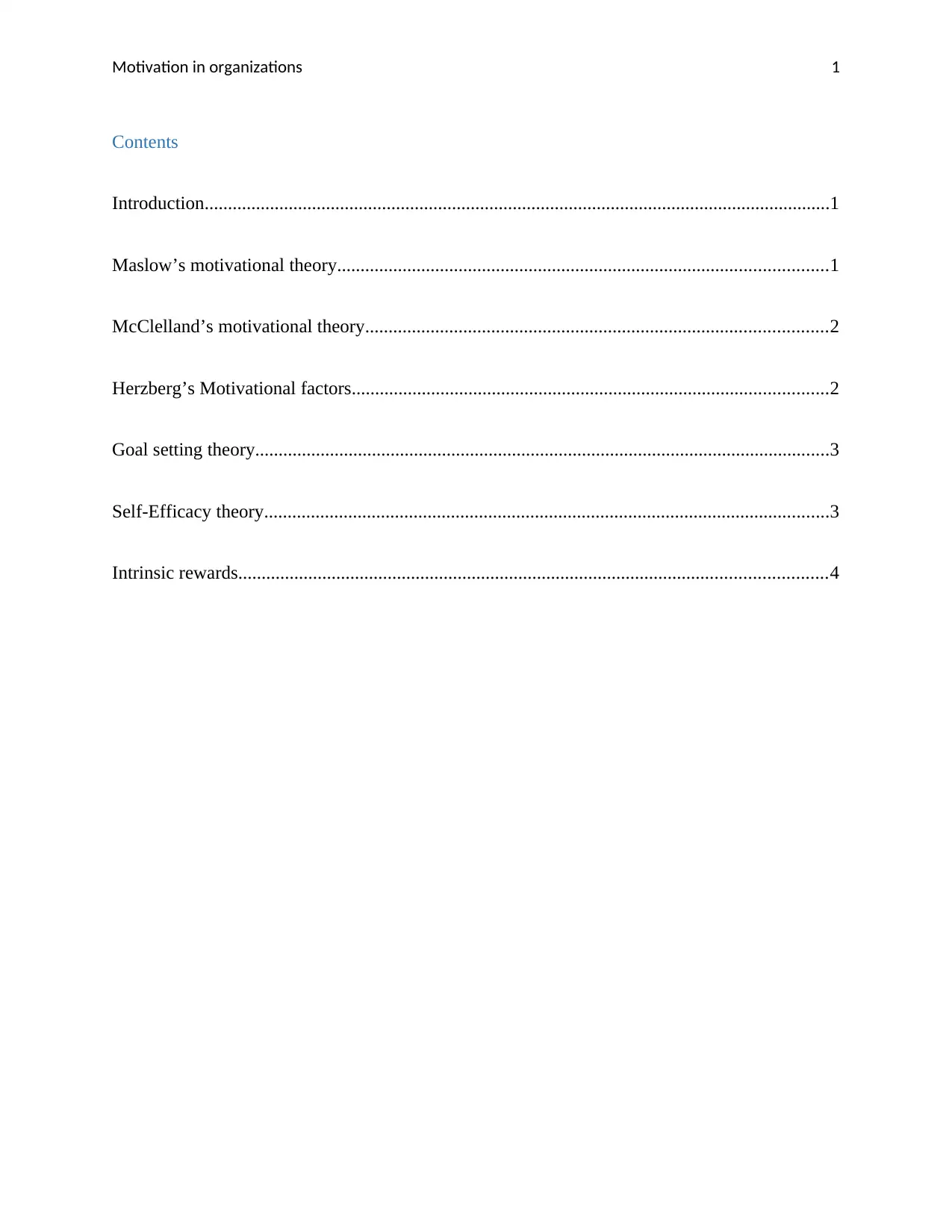
Motivation in organizations 1
Contents
Introduction......................................................................................................................................1
Maslow’s motivational theory.........................................................................................................1
McClelland’s motivational theory...................................................................................................2
Herzberg’s Motivational factors......................................................................................................2
Goal setting theory...........................................................................................................................3
Self-Efficacy theory.........................................................................................................................3
Intrinsic rewards..............................................................................................................................4
Contents
Introduction......................................................................................................................................1
Maslow’s motivational theory.........................................................................................................1
McClelland’s motivational theory...................................................................................................2
Herzberg’s Motivational factors......................................................................................................2
Goal setting theory...........................................................................................................................3
Self-Efficacy theory.........................................................................................................................3
Intrinsic rewards..............................................................................................................................4
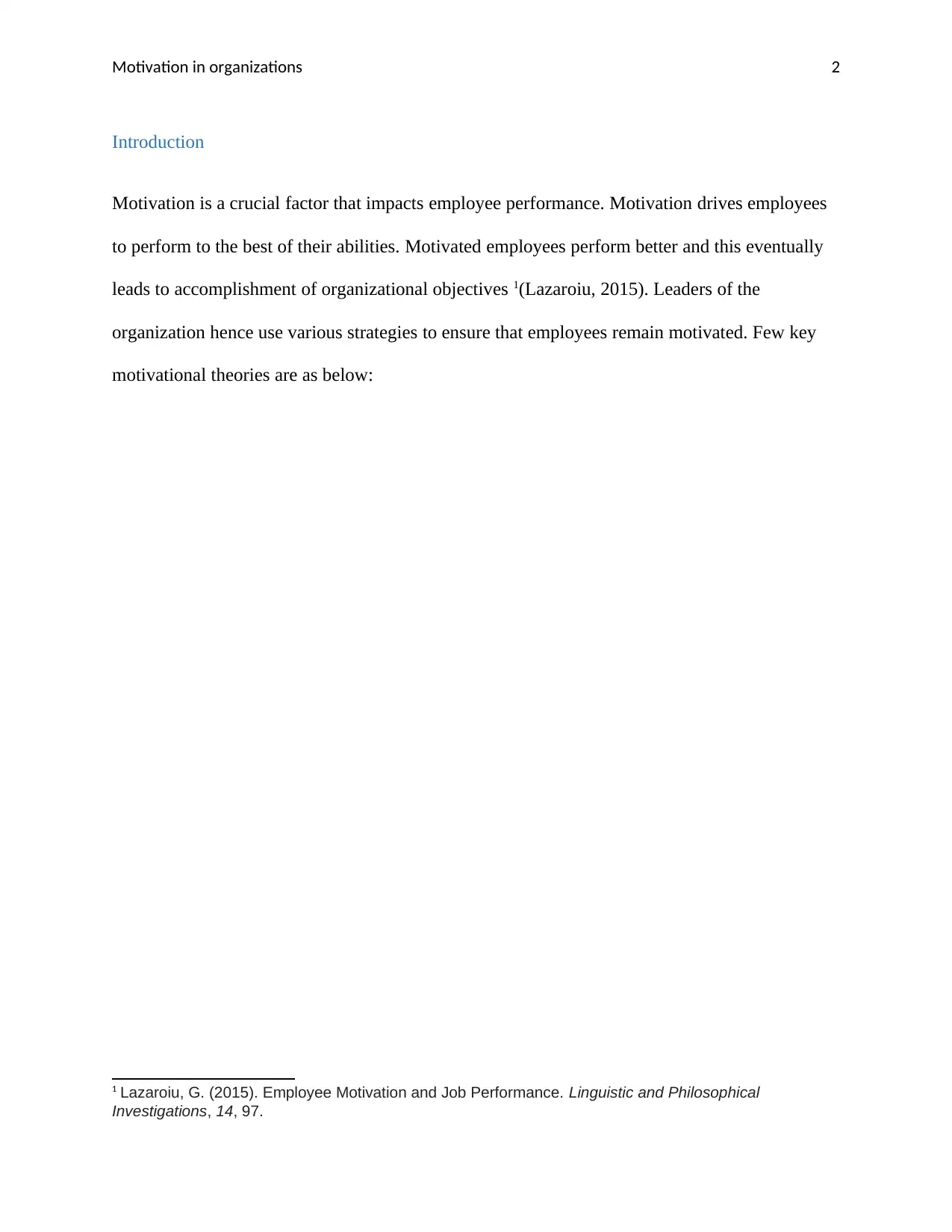
Motivation in organizations 2
Introduction
Motivation is a crucial factor that impacts employee performance. Motivation drives employees
to perform to the best of their abilities. Motivated employees perform better and this eventually
leads to accomplishment of organizational objectives 1(Lazaroiu, 2015). Leaders of the
organization hence use various strategies to ensure that employees remain motivated. Few key
motivational theories are as below:
1 Lazaroiu, G. (2015). Employee Motivation and Job Performance. Linguistic and Philosophical
Investigations, 14, 97.
Introduction
Motivation is a crucial factor that impacts employee performance. Motivation drives employees
to perform to the best of their abilities. Motivated employees perform better and this eventually
leads to accomplishment of organizational objectives 1(Lazaroiu, 2015). Leaders of the
organization hence use various strategies to ensure that employees remain motivated. Few key
motivational theories are as below:
1 Lazaroiu, G. (2015). Employee Motivation and Job Performance. Linguistic and Philosophical
Investigations, 14, 97.
⊘ This is a preview!⊘
Do you want full access?
Subscribe today to unlock all pages.

Trusted by 1+ million students worldwide
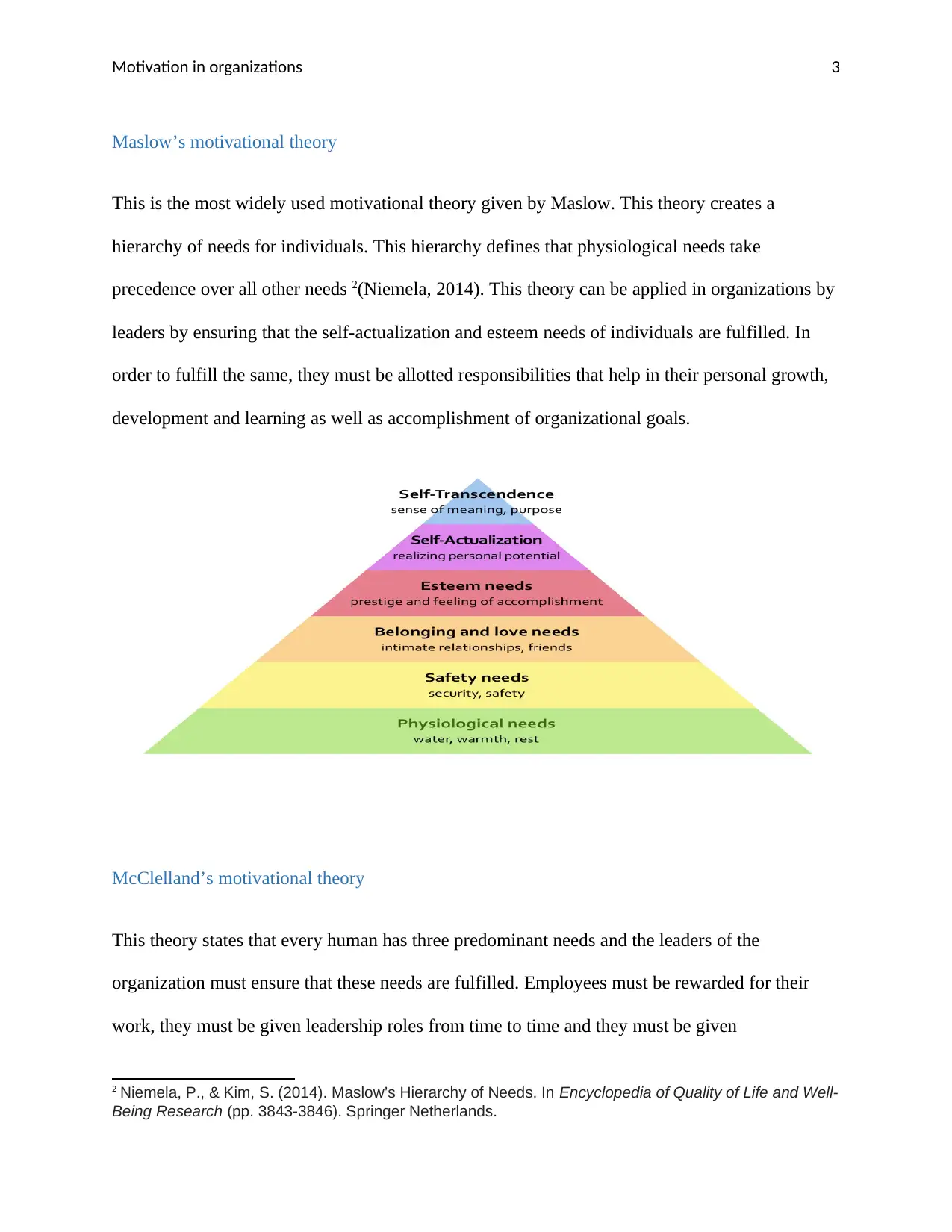
Motivation in organizations 3
Maslow’s motivational theory
This is the most widely used motivational theory given by Maslow. This theory creates a
hierarchy of needs for individuals. This hierarchy defines that physiological needs take
precedence over all other needs 2(Niemela, 2014). This theory can be applied in organizations by
leaders by ensuring that the self-actualization and esteem needs of individuals are fulfilled. In
order to fulfill the same, they must be allotted responsibilities that help in their personal growth,
development and learning as well as accomplishment of organizational goals.
McClelland’s motivational theory
This theory states that every human has three predominant needs and the leaders of the
organization must ensure that these needs are fulfilled. Employees must be rewarded for their
work, they must be given leadership roles from time to time and they must be given
2 Niemela, P., & Kim, S. (2014). Maslow’s Hierarchy of Needs. In Encyclopedia of Quality of Life and Well-
Being Research (pp. 3843-3846). Springer Netherlands.
Maslow’s motivational theory
This is the most widely used motivational theory given by Maslow. This theory creates a
hierarchy of needs for individuals. This hierarchy defines that physiological needs take
precedence over all other needs 2(Niemela, 2014). This theory can be applied in organizations by
leaders by ensuring that the self-actualization and esteem needs of individuals are fulfilled. In
order to fulfill the same, they must be allotted responsibilities that help in their personal growth,
development and learning as well as accomplishment of organizational goals.
McClelland’s motivational theory
This theory states that every human has three predominant needs and the leaders of the
organization must ensure that these needs are fulfilled. Employees must be rewarded for their
work, they must be given leadership roles from time to time and they must be given
2 Niemela, P., & Kim, S. (2014). Maslow’s Hierarchy of Needs. In Encyclopedia of Quality of Life and Well-
Being Research (pp. 3843-3846). Springer Netherlands.
Paraphrase This Document
Need a fresh take? Get an instant paraphrase of this document with our AI Paraphraser
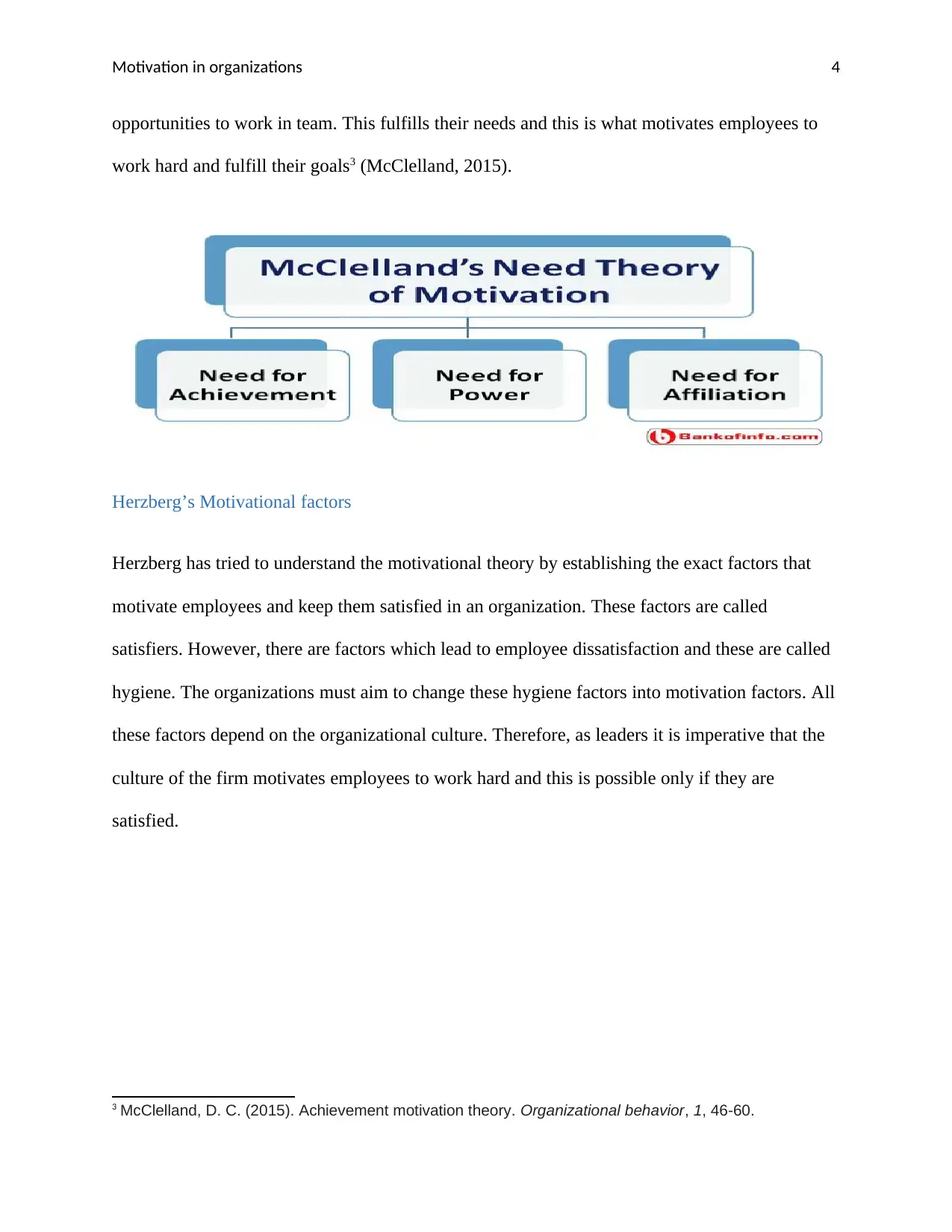
Motivation in organizations 4
opportunities to work in team. This fulfills their needs and this is what motivates employees to
work hard and fulfill their goals3 (McClelland, 2015).
Herzberg’s Motivational factors
Herzberg has tried to understand the motivational theory by establishing the exact factors that
motivate employees and keep them satisfied in an organization. These factors are called
satisfiers. However, there are factors which lead to employee dissatisfaction and these are called
hygiene. The organizations must aim to change these hygiene factors into motivation factors. All
these factors depend on the organizational culture. Therefore, as leaders it is imperative that the
culture of the firm motivates employees to work hard and this is possible only if they are
satisfied.
3 McClelland, D. C. (2015). Achievement motivation theory. Organizational behavior, 1, 46-60.
opportunities to work in team. This fulfills their needs and this is what motivates employees to
work hard and fulfill their goals3 (McClelland, 2015).
Herzberg’s Motivational factors
Herzberg has tried to understand the motivational theory by establishing the exact factors that
motivate employees and keep them satisfied in an organization. These factors are called
satisfiers. However, there are factors which lead to employee dissatisfaction and these are called
hygiene. The organizations must aim to change these hygiene factors into motivation factors. All
these factors depend on the organizational culture. Therefore, as leaders it is imperative that the
culture of the firm motivates employees to work hard and this is possible only if they are
satisfied.
3 McClelland, D. C. (2015). Achievement motivation theory. Organizational behavior, 1, 46-60.
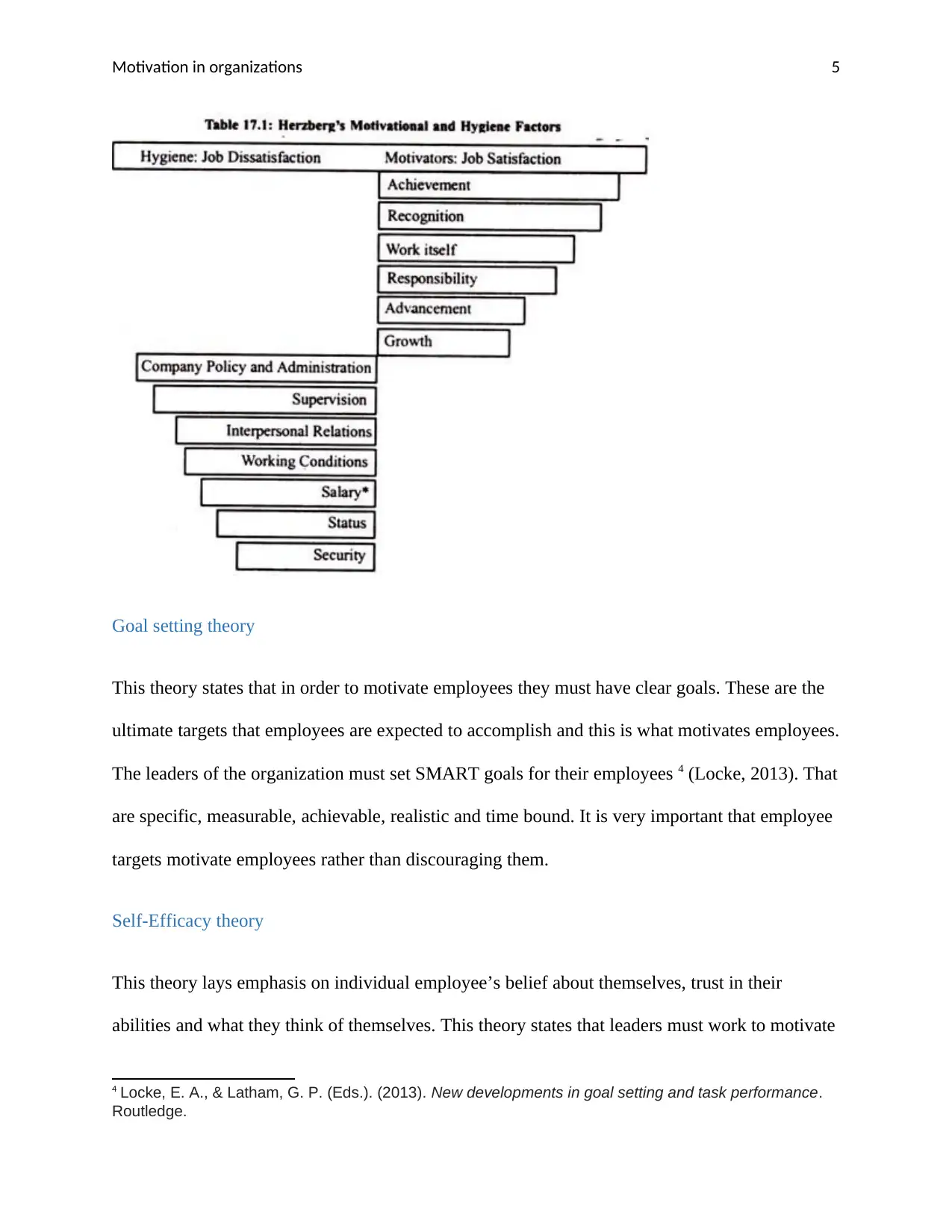
Motivation in organizations 5
Goal setting theory
This theory states that in order to motivate employees they must have clear goals. These are the
ultimate targets that employees are expected to accomplish and this is what motivates employees.
The leaders of the organization must set SMART goals for their employees 4 (Locke, 2013). That
are specific, measurable, achievable, realistic and time bound. It is very important that employee
targets motivate employees rather than discouraging them.
Self-Efficacy theory
This theory lays emphasis on individual employee’s belief about themselves, trust in their
abilities and what they think of themselves. This theory states that leaders must work to motivate
4 Locke, E. A., & Latham, G. P. (Eds.). (2013). New developments in goal setting and task performance.
Routledge.
Goal setting theory
This theory states that in order to motivate employees they must have clear goals. These are the
ultimate targets that employees are expected to accomplish and this is what motivates employees.
The leaders of the organization must set SMART goals for their employees 4 (Locke, 2013). That
are specific, measurable, achievable, realistic and time bound. It is very important that employee
targets motivate employees rather than discouraging them.
Self-Efficacy theory
This theory lays emphasis on individual employee’s belief about themselves, trust in their
abilities and what they think of themselves. This theory states that leaders must work to motivate
4 Locke, E. A., & Latham, G. P. (Eds.). (2013). New developments in goal setting and task performance.
Routledge.
⊘ This is a preview!⊘
Do you want full access?
Subscribe today to unlock all pages.

Trusted by 1+ million students worldwide
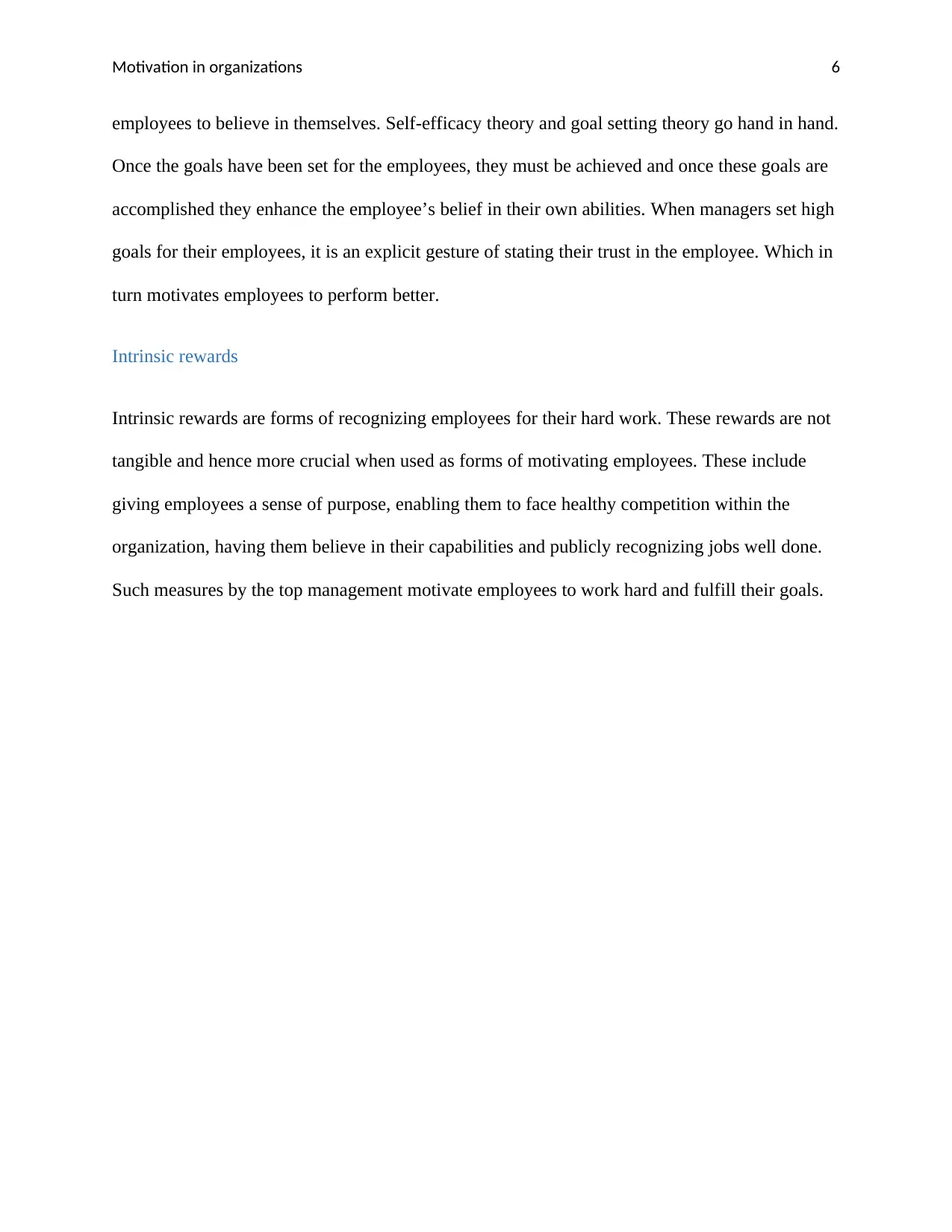
Motivation in organizations 6
employees to believe in themselves. Self-efficacy theory and goal setting theory go hand in hand.
Once the goals have been set for the employees, they must be achieved and once these goals are
accomplished they enhance the employee’s belief in their own abilities. When managers set high
goals for their employees, it is an explicit gesture of stating their trust in the employee. Which in
turn motivates employees to perform better.
Intrinsic rewards
Intrinsic rewards are forms of recognizing employees for their hard work. These rewards are not
tangible and hence more crucial when used as forms of motivating employees. These include
giving employees a sense of purpose, enabling them to face healthy competition within the
organization, having them believe in their capabilities and publicly recognizing jobs well done.
Such measures by the top management motivate employees to work hard and fulfill their goals.
employees to believe in themselves. Self-efficacy theory and goal setting theory go hand in hand.
Once the goals have been set for the employees, they must be achieved and once these goals are
accomplished they enhance the employee’s belief in their own abilities. When managers set high
goals for their employees, it is an explicit gesture of stating their trust in the employee. Which in
turn motivates employees to perform better.
Intrinsic rewards
Intrinsic rewards are forms of recognizing employees for their hard work. These rewards are not
tangible and hence more crucial when used as forms of motivating employees. These include
giving employees a sense of purpose, enabling them to face healthy competition within the
organization, having them believe in their capabilities and publicly recognizing jobs well done.
Such measures by the top management motivate employees to work hard and fulfill their goals.
Paraphrase This Document
Need a fresh take? Get an instant paraphrase of this document with our AI Paraphraser
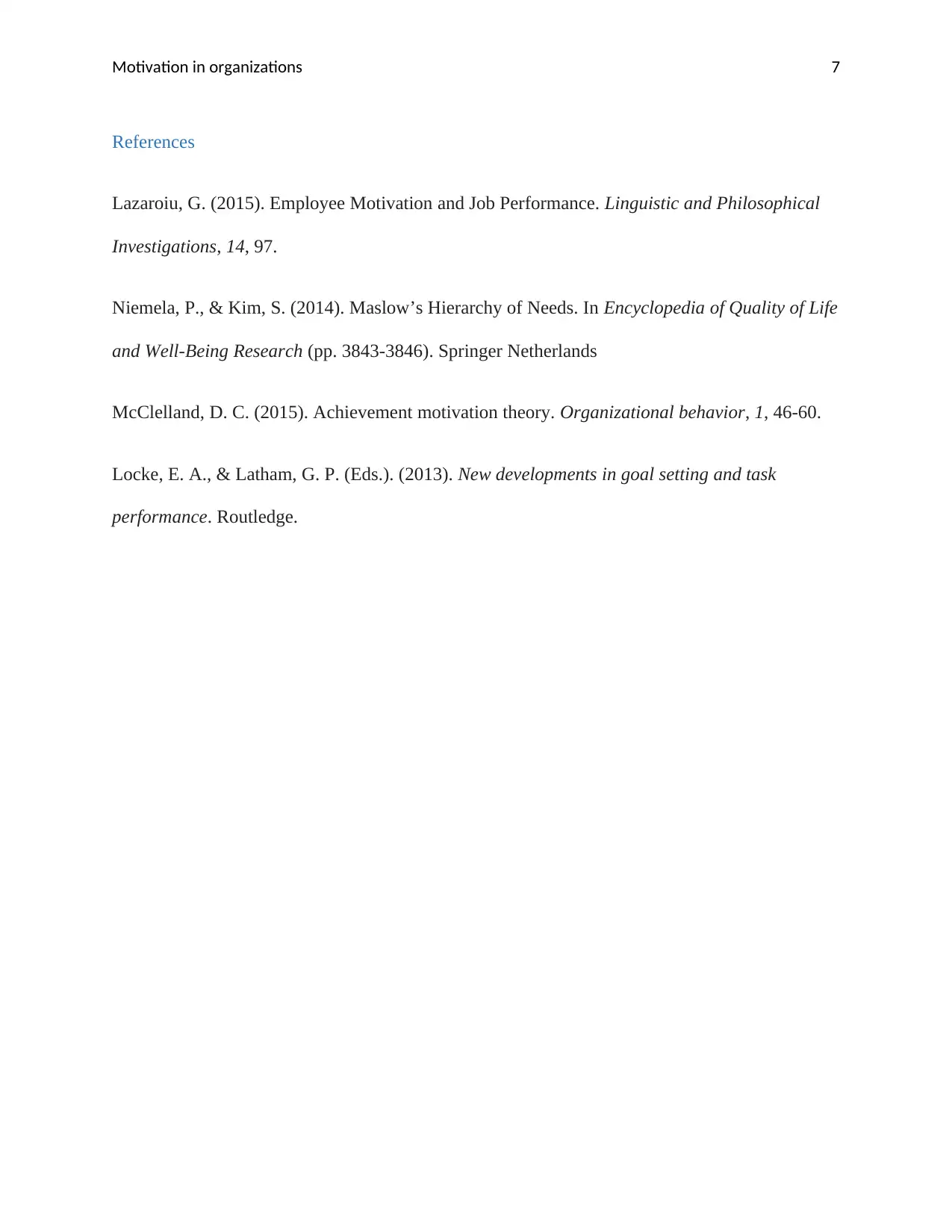
Motivation in organizations 7
References
Lazaroiu, G. (2015). Employee Motivation and Job Performance. Linguistic and Philosophical
Investigations, 14, 97.
Niemela, P., & Kim, S. (2014). Maslow’s Hierarchy of Needs. In Encyclopedia of Quality of Life
and Well-Being Research (pp. 3843-3846). Springer Netherlands
McClelland, D. C. (2015). Achievement motivation theory. Organizational behavior, 1, 46-60.
Locke, E. A., & Latham, G. P. (Eds.). (2013). New developments in goal setting and task
performance. Routledge.
References
Lazaroiu, G. (2015). Employee Motivation and Job Performance. Linguistic and Philosophical
Investigations, 14, 97.
Niemela, P., & Kim, S. (2014). Maslow’s Hierarchy of Needs. In Encyclopedia of Quality of Life
and Well-Being Research (pp. 3843-3846). Springer Netherlands
McClelland, D. C. (2015). Achievement motivation theory. Organizational behavior, 1, 46-60.
Locke, E. A., & Latham, G. P. (Eds.). (2013). New developments in goal setting and task
performance. Routledge.
1 out of 8
Related Documents
Your All-in-One AI-Powered Toolkit for Academic Success.
+13062052269
info@desklib.com
Available 24*7 on WhatsApp / Email
![[object Object]](/_next/static/media/star-bottom.7253800d.svg)
Unlock your academic potential
Copyright © 2020–2025 A2Z Services. All Rights Reserved. Developed and managed by ZUCOL.





